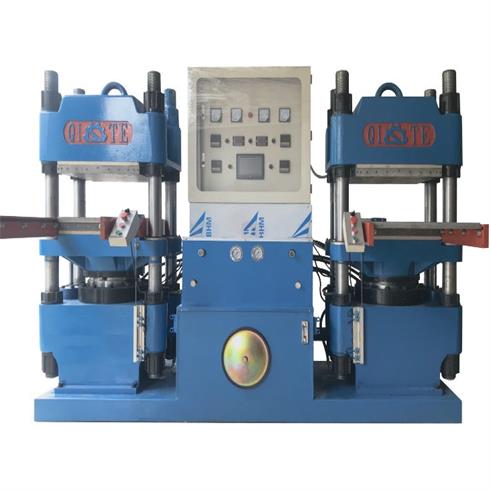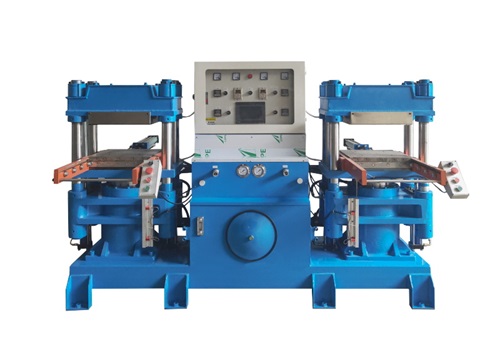
Silicone Molding Machines can work with a wide range of silicone rubber formulations, allowing for the creation of products with varying hardness, colors, and properties. This versatility enables manufacturers to produce a diverse array of items to meet specific needs.Silicone molding machines can reproduce intricate and complex shapes with high precision. This capability is particularly advantageous for industries that require customized designs or detailed patterns.Silicone molding machines produce consistent and high-quality products, ensuring that each finished item meets strict standards and specifications. This level of consistency is crucial in industries such as medical devices and aerospace.The silicone molding process is relatively fast, especially when compared to traditional manufacturing methods. This rapid production speed allows for efficient manufacturing and quicker time-to-market for new products.
Model | YX-LG150T-2H |
Hot plate specification | 490*490mm |
Hot plate spacing | 250mm |
Cylinder diameter | 290mm |
Machine structure | Four column/single head/double head model |
System pressure | 18MPa |
Heating system | Imported electric heating tube |
Power supply specification | 380V/50HZ |

Essential details | |||
Place of Origin | China | Applicable Industries | Hotels, Machinery Repair Shops, Home Use |
Type | Showroom Location | None | |
Condition | New | Model | YX-LG150T-2H |
Video outgoing-inspection | Provided | Hot plate specification | 490*490mm |
Machinery Test Report | Provided | Hot plate spacing | 250mm |
Warranty of core components | 1 Year | Cylinder diameter | 290mm |
Core Components | PLC | Motor power | 5.5KW |
Voltage | 380V/50HZ | Temperature range | Normal temperature -350°C |
Dimension(L*W*H) | 1.8*2.9*1.65(m) | Working level | Upper and lower layer |
Warranty | 1 Year | Machine structure | Four column/single head/double head model |
Key Selling Points | Automatic | System pressure | 18MPa |
Power (kW) | 15 kW | Power | 380V/50HZ |
Weight (KG) | 4400 KG | ||
Silicone Molding Equipment
The use method of silicone molding equipment:Using silicone molding equipment involves several steps to create molds from a variety of materials, such as resin, clay, wax, and more. Silicone molds are flexible and versatile, making them popular for creating intricate shapes and reproducing detailed objects.
1.Prepare the Original Object:Clean the original object to remove dust, dirt, and any contaminants.Apply a thin layer of release agent to the surface of the object to prevent the silicone from sticking.
2.Mix the Silicone:Follow the manufacturer's instructions for mixing the liquid silicone.
3.Pour the Silicone:Start by pouring a thin layer of silicone into the mold box to capture fine details.
Place your object in the mold box, ensuring it's properly positioned.
4.Demolding:Once the silicone has fully cured, carefully remove the mold box or support structures.Gently flex or peel the silicone away from the original object.
5.Trimming and Cleaning:Trim any excess silicone and clean up the mold's edges for a neat finish.
Silicone molding machines find applications in medical, electronics, automotive, toy industries, and more. In the medical field, they are used for manufacturing medical device seals; in electronics, for producing electronic components; and in the automotive industry, for manufacturing automotive seals.
The production speed of silicone molding machines depends on the complexity of the product and the mold design. Typically, silicone molding machines can complete one molding cycle in a short period, allowing for rapid production of silicone products.
Mold designs for silicone molding machines need to consider factors such as product shape, size, and wall thickness. Molds must possess characteristics like high-temperature resistance and durability to ensure the silicone, once injected, takes the desired shape.
Maintenance of silicone molding machines involves regular cleaning, lubrication, and checking for wear and tear on components. Timely replacement of damaged parts ensures the stability and long-term use of the equipment.
Modern silicone molding machines often incorporate advanced heating and cooling systems to enhance energy efficiency. They produce high-quality products while minimizing energy consumption, promoting energy efficiency and environmental sustainability.
The choice of silicone material in silicone molding machines depends on the product's purpose and requirements. Different types of silicone materials have varying hardness, high-temperature resistance, and wear resistance, requiring suitable material selection based on product characteristics.
Silicone molding machines and injection molding machines are both used to manufacture plastic products. However, silicone molding machines are specifically designed for producing silicone products, while injection molding machines are generally used for other types of plastic products.
In the medical industry, silicone molding machines are commonly used to manufacture medical device seals, IV components, and more. Silicone's biocompatibility and high-temperature resistance make it widely used in medical device manufacturing.
Operating silicone molding machines usually requires training. Operators need to be familiar with the equipment's control systems, mold replacement, silicone material preparation, and other skills to ensure the smooth progress of the production process.
What Are the Future Trends in Silicone Molding Machines?
Future trends in silicone molding machines include the application of intelligent control systems, increased production efficiency, innovative mold designs, and diversification. With technological advancements, silicone molding machines will become smarter, more efficient, and versatile.